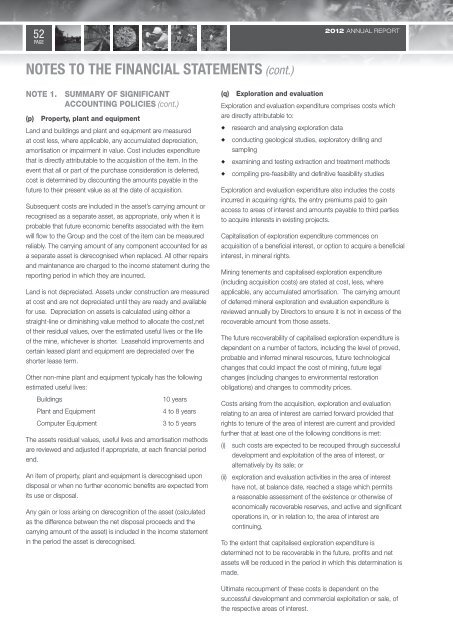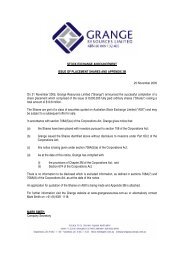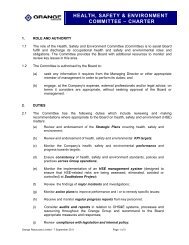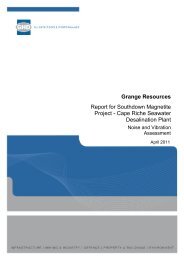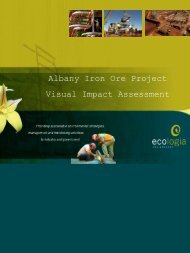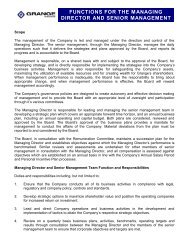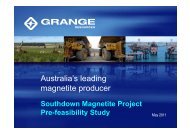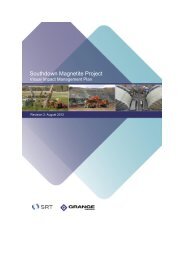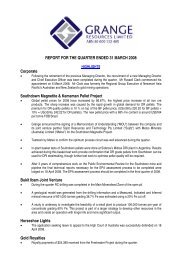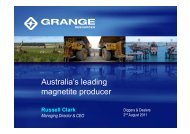2012 Annual Report (2 April 2013) - Grange Resources
2012 Annual Report (2 April 2013) - Grange Resources
2012 Annual Report (2 April 2013) - Grange Resources
You also want an ePaper? Increase the reach of your titles
YUMPU automatically turns print PDFs into web optimized ePapers that Google loves.
52<br />
PAGE<br />
<strong>2012</strong> ANNUAL REPORT<br />
Notes to the Financial Statements (cont.)<br />
NOTE 1. SUMMARY OF SIGNIFICANT<br />
ACCOUNTING POLICIES (cont.)<br />
(p)<br />
Property, plant and equipment<br />
Land and buildings and plant and equipment are measured<br />
at cost less, where applicable, any accumulated depreciation,<br />
amortisation or impairment in value. Cost includes expenditure<br />
that is directly attributable to the acquisition of the item. In the<br />
event that all or part of the purchase consideration is deferred,<br />
cost is determined by discounting the amounts payable in the<br />
future to their present value as at the date of acquisition.<br />
Subsequent costs are included in the asset’s carrying amount or<br />
recognised as a separate asset, as appropriate, only when it is<br />
probable that future economic benefits associated with the item<br />
will flow to the Group and the cost of the item can be measured<br />
reliably. The carrying amount of any component accounted for as<br />
a separate asset is derecognised when replaced. All other repairs<br />
and maintenance are charged to the income statement during the<br />
reporting period in which they are incurred.<br />
Land is not depreciated. Assets under construction are measured<br />
at cost and are not depreciated until they are ready and available<br />
for use. Depreciation on assets is calculated using either a<br />
straight-line or diminishing value method to allocate the cost,net<br />
of their residual values, over the estimated useful lives or the life<br />
of the mine, whichever is shorter. Leasehold improvements and<br />
certain leased plant and equipment are depreciated over the<br />
shorter lease term.<br />
Other non-mine plant and equipment typically has the following<br />
estimated useful lives:<br />
Buildings<br />
10 years<br />
Plant and Equipment<br />
4 to 8 years<br />
Computer Equipment<br />
3 to 5 years<br />
The assets residual values, useful lives and amortisation methods<br />
are reviewed and adjusted if appropriate, at each financial period<br />
end.<br />
An item of property, plant and equipment is derecognised upon<br />
disposal or when no further economic benefits are expected from<br />
its use or disposal.<br />
Any gain or loss arising on derecognition of the asset (calculated<br />
as the difference between the net disposal proceeds and the<br />
carrying amount of the asset) is included in the income statement<br />
in the period the asset is derecognised.<br />
(q) Exploration and evaluation<br />
Exploration and evaluation expenditure comprises costs which<br />
are directly attributable to:<br />
◆◆<br />
research and analysing exploration data<br />
◆◆<br />
◆◆<br />
◆◆<br />
conducting geological studies, exploratory drilling and<br />
sampling<br />
examining and testing extraction and treatment methods<br />
compiling pre-feasibility and definitive feasibility studies<br />
Exploration and evaluation expenditure also includes the costs<br />
incurred in acquiring rights, the entry premiums paid to gain<br />
access to areas of interest and amounts payable to third parties<br />
to acquire interests in existing projects.<br />
Capitalisation of exploration expenditure commences on<br />
acquisition of a beneficial interest, or option to acquire a beneficial<br />
interest, in mineral rights.<br />
Mining tenements and capitalised exploration expenditure<br />
(including acquisition costs) are stated at cost, less, where<br />
applicable, any accumulated amortisation. The carrying amount<br />
of deferred mineral exploration and evaluation expenditure is<br />
reviewed annually by Directors to ensure it is not in excess of the<br />
recoverable amount from those assets.<br />
The future recoverability of capitalised exploration expenditure is<br />
dependent on a number of factors, including the level of proved,<br />
probable and inferred mineral resources, future technological<br />
changes that could impact the cost of mining, future legal<br />
changes (including changes to environmental restoration<br />
obligations) and changes to commodity prices.<br />
Costs arising from the acquisition, exploration and evaluation<br />
relating to an area of interest are carried forward provided that<br />
rights to tenure of the area of interest are current and provided<br />
further that at least one of the following conditions is met:<br />
(i) such costs are expected to be recouped through successful<br />
development and exploitation of the area of interest, or<br />
alternatively by its sale; or<br />
(ii) exploration and evaluation activities in the area of interest<br />
have not, at balance date, reached a stage which permits<br />
a reasonable assessment of the existence or otherwise of<br />
economically recoverable reserves, and active and significant<br />
operations in, or in relation to, the area of interest are<br />
continuing.<br />
To the extent that capitalised exploration expenditure is<br />
determined not to be recoverable in the future, profits and net<br />
assets will be reduced in the period in which this determination is<br />
made.<br />
Ultimate recoupment of these costs is dependent on the<br />
successful development and commercial exploitation or sale, of<br />
the respective areas of interest.


